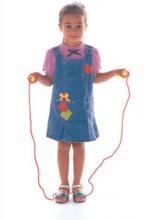
The jump rope is a familiar children’s toy on the playground. It has been a popular toy for centuries and was inducted into the National Toy Hall of Fame in 2000. While rope skipping has been seen in many cultures around the world, early Dutch settlers brought the activity to America in the 17th century where it began as a boy’s activity. By the 18th century girls were also jumping ropes and adding rhythmic songs, such as “Teddy Bear, Teddy Bear, turn around, Teddy Bear, Teddy Bear, touch the ground” and “Cinderella, dressed in yellow, went up stairs to kiss a fellow.”1
Jump ropes are affordable, lightweight, and portable and offer exercise as well as fun activities for children. Jumping rope builds lower body strength in the legs, works the upper arm muscles, and gives an aerobic workout by increasing blood flow and raising the heart rate.2 Rope jumping also aids in the development of coordination, agility, and endurance and can be enjoyed alone or in groups.3 When one or two long ropes are swung for other children to jump, these group games help the children develop self-regulation while they wait their turns as well as cooperation in allowing the rope swingers to have their own turns at jumping.
A jump rope for an individual child is the correct length when the child can stand on its center and have both ends come up to his armpits. Jump ropes can be made of cloth that is braided into a rope, but popular ropes for children are nylon cords encased by small separate flexible plastic or polyurethane sections, known as beaded jump ropes. The beaded ropes are more durable on harsh surfaces, such as concrete, than cloth ropes that can be worn down rapidly. Speed ropes are made from thin vinyl cord that is best for indoor use. Because they are lighter and faster than a beaded rope, they are used more by athletes for conditioning. Longer jump ropes can range from 14 feet to 60 feet to accommodate multiple jumpers and are often cloth ropes or beaded ropes.4
Double Dutch jump rope games require two jump ropes to be held by two players at either end swinging them simultaneously with one rope in the left hand and the other in the right hand. Other children then take turns jumping in and out of the ropes as they go around often chanting rhythmic songs to help keep the beat. The songs are also used as games, such as calling other players to join in with “I like coffee, I like tea, I like Susie to jump with me.”5
Jump roping has grown beyond the casual play on the playground to competitive sport in national competitions. USA Jump Rope (USAJR) was formed in 1995 as a nonprofit organization that offers jump rope workshops, camps, seminars, and tournaments at the state, regional, and national levels.6
- 1. “Jump Rope.” National Toy Hall of Fame. < http://www.toyhalloffame.org/toys/jump-rope > 11 Nov. 2011.
- 2. Roberts, Holly L. “Jump Rope Information for Kids.” Livestrong. < http://www.livestrong.com/article/40704-jump-rope-information-kids/ > 10 Nov. 2011.
- 3. Martin, Lou. “Basics of Jump Rope for Kids.” Livestrong. < http://www.livestrong.com/article/524158-basics-of-jump-rope-for-kids/ > 10 Nov. 2011.
- 4. McGee, Suzanna. “Different Kinds of Jump Ropes.” Livestrong. < http://www.livestrong.com/article/142506-different-kinds-jump-ropes/ > 10 Nov. 2011.
- 5. Stewart, Tom. “Double Dutch & Other Jump Rope Games.” Livestrong. < http://www.livestrong.com/article/373494-double-dutch-other-jump-rope-games/ > 10 Nov. 2011.
- 6. “USA Jump Rope.” USA Jump Rope. < http://www.usajrf.org/about.asp > 10 Nov. 2011.

